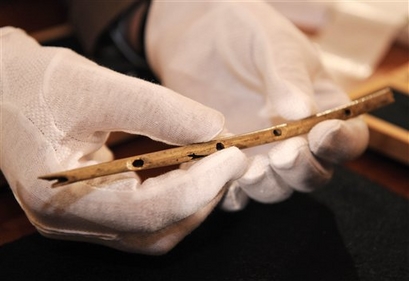
© AP Photo/Daniel MaurerProfessor Nicholas Conard of the University in Tuebingen shows a flute during a press conference in Tuebingen, southern Germany, on Wednesday, June 24, 2009
A bird-bone flute unearthed in a German cave was carved some 35,000 years ago and is the oldest handcrafted musical instrument yet discovered, archaeologists say, offering the latest evidence that early modern humans in Europe had established a complex and creative culture.
A team led by University of Tuebingen archaeologist Nicholas Conard assembled the flute from 12 pieces of griffon vulture bone scattered in a small plot of the Hohle Fels cave in southern Germany.
Together, the pieces comprise a 8.6-inch (22-centimeter) instrument with five holes and a notched end. Conard said the flute was 35,000 years old.


